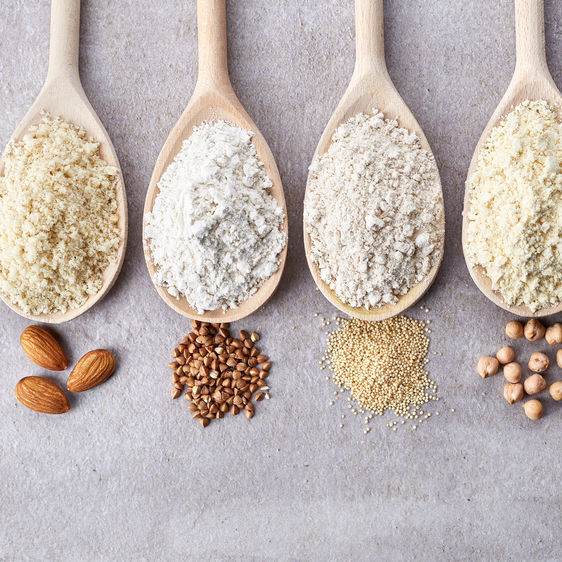
Gluten-free Flours
Also known as gluten-free blends
What are Gluten-free Flours?
Gluten-free flours or blends are dry mixes that can replace or substitute gluten in bakery products such as bread, pizza, cookies, pasta or cakes. They rely on a proper balance of components that resemble as much as possible the functionality and properties of wheat gluten-forming proteins.
Current consumer awareness of gluten allergenicity and other related disorders (celiacs) have created the need for the development of good tasting and healthy gluten-free products.
Challenges with formulating gluten-free flours
Several factors still limit the development of gluten-free flours. A few are:
- Ensuring good gas retention by creating a hydrated and cohesive network to trap gases produced by yeast fermentation, chemical leaveners and oven baking.
- Formulating a wheatless dough of optimum handling properties like elasticity, extensibility, and stickiness. Also, the dough must expand and machine properly.
- Generating an oil-in-water emulsion or batter of optimum viscosity and bench tolerance.
- Producing baked goods with optimum color and volume, chewy texture and an airy/porous mouthfeel.
These goals can be achieved by using alternative starch- and protein-rich sources and often include hydrocolloids. The choice of ingredients and their levels vary with the end product. For example, a gluten-free flour intended for gluten-free bread might differ markedly from a gluten-free blend formulated for cakes or cookies.
Application
Components of gluten-free flours1,2
- Starch sources
- Protein sources
- Dried egg whites
- Dried whole eggs
- Legumes or pulses: beans, soybeans, lentils, dry peas, chickpeas, lupins
- Enzyme-active soy flour
- Pseudocereals: quinoa, amaranth, buckwheat
- Nonfat dry milk or milk solids (Whey/soy flour blends can be used as substitutes)
- Dried fruits, tree nuts (e.g. almond flour)
- Sodium or calcium caseinate
- Milk protein isolates
- Hydrocolloids (gums)
- Xanthan gum
- Gellan gum
- Carboxymethylcellulose (CMC)
- Guar gum
- Locust bean
- Gum Arabic (Acacia gum)
- Gelatin
- Pectin
- Alginate
- Psyllium husk
- Agar
- Carrageenan
- Modified starches
- Pregelatinized or instant
- Cross-linked
- Oxidized
- Stabilized starch
- Dough conditioners
- Starch-complexing materials (emulsifiers)
- Amylase
- Transglutaminase
- Sugar oxidase
- Leavening systems
- Active or instant dry yeast
- Baking powder
Functionality of main gluten-free flour components 1,2
| Ingredient | Function |
| Starch sources |
|
| Protein sources |
|
| Hydrocolloids / modified starches |
|
| Enzymes, emulsifiers |
|
[fusion_separator style_type=”default” hide_on_mobile=”small-visibility,medium-visibility,large-visibility” class=”” id=”” sep_color=”#ffffff” top_margin=”5″ bottom_margin=”10″ border_size=”” icon=”” icon_circle=”” icon_circle_color=”” width=”” alignment=”center”][/fusion_separator]
Many gluten-free flours or blends are found at both retail and wholesale levels. They are available as complete dry formulas or can be readily made into dough that may need incorporation of unique minor and micro ingredients.
When considering a gluten-free blend, it is important to confirm that the facility where it is produced has a gluten-free certification and that the dry mixes are tested before receipt, with a corresponding certificate of analysis confirming the results.
Leavening systems
Gluten-free flours intended for the production of gluten-free bread can incorporate dry yeast forms (e.g. ADY, IDY) along with specially formulated baking powders.
Given the limited gas retention capacity of the dough-like mixture, quick processing must be carried out to prevent excessive gas loss. Makeup stage is usually not possible given the inferior rheology, consistency and handling properties of the gluten-free dough.
Chemical leaveners in a gluten-free blend may include a slow-acting or heat-triggered leavening acid, or a coated baking powder. These forms allow a better control and delayed gas release that help the product attain and keep optimum volume throughout processing.
References
- Arendt, E.K. “Gluten-free breads.” Gluten-free Cereal Products and Beverages, Academic Press, Elsevier Inc., 2008, pp. 289–310.
- Casper, J.L., and Atwell, W.A. “Gluten-Free Ingredients.” Gluten-free Baked Goods, AACC International, Inc., 2014, pp. 23–47.

